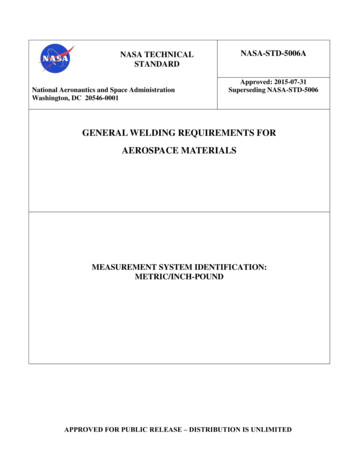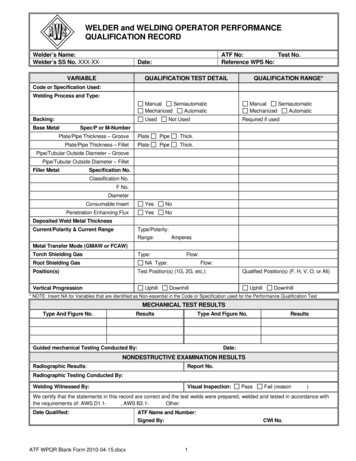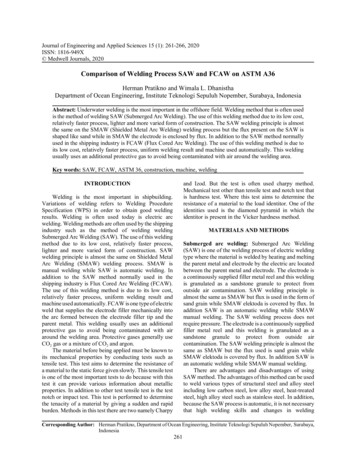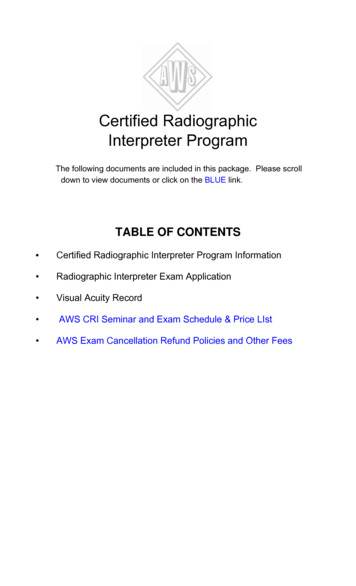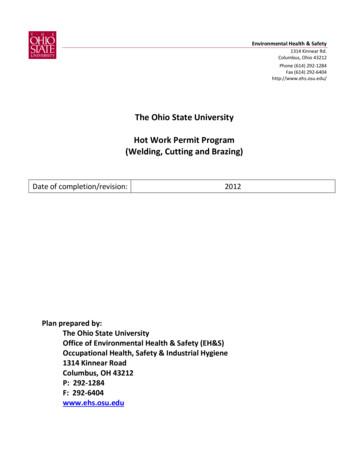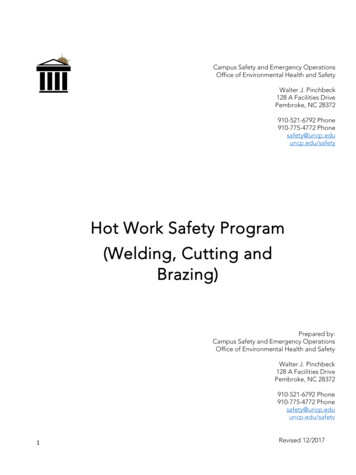
Transcription
Campus Safety and Emergency OperationsOffice of Environmental Health and SafetyWalter J. Pinchbeck128 A Facilities DrivePembroke, NC 28372910-521-6792 Phone910-775-4772 Phonesafety@uncp.eduuncp.edu/safetyHot Work Safety Program(Welding, Cutting andBrazing)Prepared by:Campus Safety and Emergency OperationsOffice of Environmental Health and SafetyWalter J. Pinchbeck128 A Facilities DrivePembroke, NC 28372910-521-6792 Phone910-775-4772 Phonesafety@uncp.eduuncp.edu/safety1Revised 12/2017
Table of ContentsContentsINTRODUCTION . 3RESPONSIBILTIES . 3DEFINITIONS . 4SPECIALIZED HOT WORK PRECAUTIONS . 6PERSONAL PROTECTIVE EQUIPMENT . 7VENTILATION . 8POST HOT-WORK ACTIVITES . 9TRAINING . 9RECORDKEEPING. 9Appendix A – Hot Work Permit . 10Appendix B – Hot Work Warning Sign . 11ResourcesNC DOL: Welding and CuttingOSHA 1910.252: (Welding, Cutting, and Brazing)2
INTRODUCTIONThe following Hot Work Program provides written procedures to help prevent the outbreak of fire,fire alarm activations, and smoke/odor migration in buildings resulting from work involving openflames, producing heat or sparks. This includes, but is not limited to brazing, cutting, grinding, torchsoldering, thawing pipes, and torch applied roofing and welding.This procedure applies to hot work done at The University of North Carolina at Pembroke (UNCP)by UNCP employees. Contractors working in occupied UNCP buildings must have their own writtenHot Work Program or follow the guidance in this program and submit copies of completed HotWork Permits to UNCP Environmental Health and Safety Office (EH&S).Contractors working at UNCP construction sites (new buildings or unoccupied renovation sites) arerequired to have their own written Hot Work Program; completed Hot Work Permits on constructionsites are not required to be submitted to UNCP EH&S.RESPONSIBILTIESEnvironmental Health & Safety Is responsible for maintaining the written Hot Work Program;Is responsible for providing and maintaining Hot Work Permits to UNCP employees whennotified of hot work activities. Additionally, EH&S staff conducts hot work permit inspectionsand approvals prior to hot work being done; andEH&S accepts completed Hot Work Permits from contractors performing hot work activitiesin occupied UNCP buildings. EH&S will provide assistance to contractors upon request.Supervisors/Project Managers Ensure employees conducting hot work have received proper training and are providedappropriate equipment and personal protective equipment to complete the job safely;Be capable of identifying hazards when hot work is anticipated;Ensure Hot Work Permits are completed and submitted to EH&S for approval; andEnsure hired contractors have their own Hot Work Program or follow the guidance in thisprogram and provide EH&S with completed permits.Authorized EmployeesAuthorized employees are those who have received appropriate training and possess adequateknowledge to safely conduct hot work and are responsible for the following: 3Ensure the safe handling of cutting or welding equipment and safe use during the process;Identify combustible materials and hazardous areas present or likely to be present in thework area;Protect combustible materials from ignition by moving the hot work to a location free fromdangerous combustibles; or, if not feasible, moving combustibles to a safe location or
provide shielding to prevent ignition;Ensure hot work operations do not interfere with other operations in the area;Notify EH&S of all planned hot work and ensure appropriate hot work permits are completeprior to work;Ensure appropriate fire protection and extinguishing equipment are properly located at thesite;Ensure a fire watch is present, when required;Ensure smoke/fire detection devices have been adequately addressed; andEnsure HVAC precautions have been adequately addressed.Contractors Contractors are hired by the university to either make renovations or repairs to existingoccupied facilities or to build or renovate unoccupied university facilities;All contractors hired to conduct hot work at The University of North Carolina at Pembrokeshall have their own written hot work program that fulfills all regulatory requirements orfollow the guidance in this program;Contractors working in occupied UNCP buildings shall notify EH&S that hot work is beingconducted and provide copies of all hot work permits prior to commencing work; andContractors working on new construction or renovating unoccupied university facilities shallfollow their own hot work policies and procedures, which shall fulfill all regulatoryrequirements.DEFINITIONSBrazing and Soldering: Soldering and brazing use molten metal to join two pieces of metal. Themetal added during both processes has a melting point lower than that of the workpiece, so onlythe added metal is melted, not the workpiece. Brazing produces a stronger joint than doessoldering, and often is used to join metals other than steel, such as brass. Brazing can also be usedto apply coatings to parts to reduce wear and protect against corrosion.Cutting/Grinding: Any process which produces sparks capable of igniting combustible orflammable materials and transmits heat to the work material from a hot gas.Designated Area: A permanent location designed for or approved for hot work operations to beperformed regularly.Fire Watch: Trained personnel who are in attendance during the entire hot work operation and areimmediately available to extinguish a fire or take other effective action if needed.Hot Work: Any process that can be a source of ignition when flammable material is present or canbe a fire hazard regardless of the presence of flammable material in the workplace. Common hotwork processes are welding, soldering, cutting and brazing.Hot Work Permit: A document issued for the purpose of authorizing a specified activity.Welding: Joining together (metal pieces or parts) by heating the surfaces to the point of meltingusing a blowtorch, electric arc, or other means, and uniting them by pressing, hammering, etc.4
PRE-HOT WORK ACTIVITESAll hot work activities are required to have a Hot Work Permit, unless the welding, cutting orbrazing operations are being conducted in an area/shop designed to facilitate safe hot workoperations.If possible, move hot work activities to a safe area free from all combustible materials and firehazards.If hot work activities cannot be relocated to a safe area, the following precautions must be taken,in addition to acquiring the proper Hot Work Permit, to ensure fire, and other hazards, areaddressed prior to hot work commencing: Hot work permits are posted at the entrance to the work site to inform personnel of the hotwork operations taking place;Smoke detectors and sprinkler systems have been addressed by the Facilities Operationsstaff;Heating, Ventilation and Air Conditioning (HVAC) have been addressed by FacilitiesOperations staff;Ducts that might carry sparks to a distant combustible material must be suitably protectedor disengaged;Welding and cutting equipment is in proper working order; andFirst aid supplies are readily available.Precautions have been taken to protect the area within 35 feet of the hot work area:o Floors are swept clean of dust and combustibles;o Combustible floors are wetted or covered with damp sand, metal or other suitableshields;o No combustible materials or flammable liquids are present;o Combustible surfaces are protected with covers, guards or metal shields;o Combustible materials in adjacent rooms are moved away from walls;o All wall and floor openings are covered, blocked or shielded; ando Grated floors (i.e. catwalks) are protected to ensure collection of sparks during work.Precautions within 50 feet of the hot work area:o Relocate or protect explosive material, compressed gas cylinders or stored fuel.A fire watch is established and assigned to a properly trained individual.Fire WatchDuring and after hot work activities, the work area must be monitored to ensure hot work does notresult in a fire. 5Personnel assigned to fire watch responsibilities must be trained in the contents of the HotWork Program and fire extinguisher use and limitations;Fire watch must be conducted during and at least 30 minutes following the hot work activity;Appropriate fire extinguishing equipment must be readily available during fire watch; and
Fire watch personnel must have the ability to sound the fire alarm and alert the respondingFire Department in the event of a fire.Prior to commencement of hot work, an EH&S representative will inspect the work area and confirmthe aforementioned precautions have been taken to prevent fire in accordance with NFPA 51B. Itis the responsibility of the person conducting the hot work, or their supervisor, to notify EH&S ofthe scheduled work in a timely manner to ensure EH&S has sufficient time to respond to the request.Prohibited AreasCutting or welding shall not be permitted in the following situations: In unauthorized areas, such as occupied office space;In sprinklered buildings, while such protection is impaired;In the presence of explosive atmospheres or potential for explosive atmospheres;In areas near the storage of large quantities of exposed readily ignitable materials; andIn areas not approved by EH&S through the hot work permitting process.SPECIALIZED HOT WORK PRECAUTIONSPipes: Prior to cutting or welding on pipes, the operator must ensure the pipes are purged andempty; andCutting or welding on pipes or other metal in contact with combustible walls, partitions,ceilings or roofs shall not be undertaken if the work is close enough to cause ignition byconduction.Containers: No welding, cutting or other hot work shall be performed on used drums, barrels, tanks orother containers until they have been cleaned to ensure no flammable materials or vaporsare present;Pipes connected to containers must be disconnected prior to hot work; andAll hollow spaces, cavities, or containers must be vented during the hot work to permit theescape of air and gases. Purging with inert gas is recommended.Confined Space:If hot work activities are to take place in a confined space the operator must be trained under andfollow all components of the Confined Space Entry Program.Prior to hot work in a confined space the following precautions must be addressed: 6Ensure a confined space entry permit is completed;Ensure all openings/covers are open and secured from closing;Test atmosphere within the confined space for oxygen, explosives, and toxins;
Isolate lines and maintain vents open and valves leak-free;Lockout/tagout all systems not required during hot work;Provide a means for readily turning off power, gas and other supplies from outside theconfined space;Protect or remove any hazardous materials which may become hazardous when exposed tohot work; andVentilation within the confined space must be supplied to ensure fumes and gases do notexceed exposure limits and oxygen limits remain within an acceptable range.o If ventilation is not possible, the operators must be provided airline respirators or aself-contained breathing apparatus to ensure safe respirable air at all times.Respiratory protection users must have medical clearance and be included in theUniversity Respiratory Protection Program.Gas cylinders and welding machines must be left outside the confined space and secured toprevent movement during hot work operations;Where an operator must enter a confined space through a manhole or other small opening,means must be provided to quickly remove (rescue) the operator in an emergency (i.e.lifeline); andWhen breaks in hot work occur (lunch or overnight) all valves must be turned off and hosesand connections must be disconnected at the power source.PERSONAL PROTECTIVE EQUIPMENTOperators performing hot work, and any personnel assigned to the hot work project as assistantsmust be provided appropriate personal protective equipment (PPE).Eye Protection: Suitable eye protection must be provided and worn by operators and assistantsduring all hot work operations. PPE used for eye protection such as goggles, helmets and hand shields must meet minimumANSI standards; andTable 1 provides recommendations for selection of the proper shade numbers for eyeprotection based on the type of hot work being done.Protective clothing: Heat resistant clothing must be provided and worn by operators during hotwork operations. 7Other PPE including head, hand and foot protection shall be provided based on the hazardevaluation of the work area and work to be completed; andScreens shall be utilized to provide protection to the worker as well as others not involved inthe hot work.
Table 1:Welding OperationShielded metal-arc welding(1/16, 3/32, 1/8, 5/32-inch electrodes)Gas-shielded arc welding (nonferrous)(1/16, 3/32, 1/8, 5/32-inch electrodes)Gas-shielded arc welding (ferrous)(1/16, 3/32, 1/8, 5/32-inch electrodes)Shielded metal-arc welding(3/16, 7/32, 1/4-inch electrodes)Shielded metal-arc welding(5/16, 3/8-inch electrodes)Atomic hydrogen weldingCarbon arc weldingSolderingTorch brazingLight cutting(up to 1-inch)Medium cutting(1-6-inches)Heavy cutting(6-inches and over)Light gas welding(up to 1/8-inch)Medium gas welding(1/8 to 1/2-inch)Heavy gas welding(1/2-inch and over)Shade LATIONVentilation must be adequate during general welding and cutting hot workoperations.Mechanical ventilation must be provided when welding or cutting operations takeplace: In a space less than 10,000 cubic feet per welder;In a room having a ceiling height of less than 16 feet;In a confined space; andIn a space containing partitions, balconies or other structural barriers, whichmay significantly obstruct ventilation.8
Ventilation should be provided at a rate of 2,000 cubic feet per minute (CFM) perwelder unless local exhaust hoods, booths, or supplied breathing air is provided inthe work area.Natural ventilation will be considered sufficient where the restrictions in Mechanicalventilation of this plan are not present.Cutting or welding operations involving hazardous materials must be pre-approvedand reviewed by EH&S prior to work.POST HOT-WORK ACTIVITESUpon completion of hot work operations, the fire watch personnel must remain onsite for at least 30 minutes to ensure fire hazards are mitigated.Upon completion of the fire watch, the attendant must sign the hot work permitindicating the hot work is complete.As a precautionary measure, it is recommended the hot work area be inspectedagain at the end of the shift to ensure fire hazards or potential fires are properlyhandled.TRAININGSupervisors must ensure all hot work operators, fire watch personnel and assistantsreceive training relating to hot work operations.Training shall cover all aspects of the hot work program including: Pre-hot work operations;Completion of hot work permits;Personal protective equipment;Ventilation; andPost-hot work operationsRECORDKEEPINGHot work permit A copy of the hot work permit must be maintained by the shop performingthe hot work operations and EH&S.Training records Training records are maintained by the employing department in theemployees employment file. Records for training provided by EH&S will bemaintained by EH&S but should also be kept in the employment file.9
Appendix A – Hot Work Permit10
Appendix B – Hot Work Warning Sign11
safety@uncp.edu. uncp.edu/safety. Hot Work Safety Program (Welding, Cutting and Brazing) Prepared by: Campus Safety and Emergency Operations . Office of Environmental Health and Safety . Walter J. Pinchbeck . 128 A Facilities Drive . Pembroke, NC 28372 . 910-521-6792 Phone . 910-775-4772 Phone . safety@uncp.edu uncp.edu/safety Revised 12 /2017



